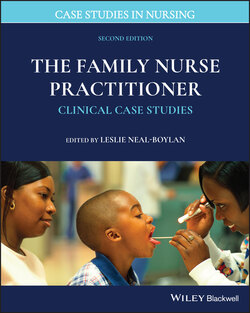Читать книгу The Family Nurse Practitioner - Группа авторов - Страница 29
ОглавлениеCase 3.4 Toothache
By Mikki Meadows‐Oliver, PhD, RN, FAAN
SUBJECTIVE
Five‐year‐old Lamont presents to the office with his father, Allen, with a complaint of a toothache. Allen states that Lamont woke in the middle of the night, crying, stating that his tooth (on the back, left side of his mouth) hurt. Allen gave Lamont an over‐the‐counter pain reliever to help with the pain. The pain reliever helped, and Lamont went back to sleep. However, when Lamont awakened this morning, he was again complaining of a toothache, and Allen decided to bring him in for a visit. Allen states that he thinks that Lamont had a fever. The family does not have a thermometer, but Lamont’s forehead felt hot. Lamont has no cough, runny nose, vomiting, or diarrhea.
Diet: Lamont’s nutrition history reveals that he has a balanced diet with enough dairy, protein, fruits, and vegetables. He also ingests quite a bit of junk food, including chips and cookies. Allen admits that Lamont sometimes drinks juice and soda from a baby bottle.
Elimination: Lamont is voiding well with no complaints of dysuria. He has 1 bowel movement daily and denies constipation or diarrhea.
Sleep: Lamont sleeps approximately 10 hours at night and has no trouble falling asleep or staying asleep.
Past medical history: Lamont was born via vaginal birth in Senegal. His birth was a home birth attended by a local midwife. The exact number of weeks’ gestation is unknown, but Lamont’s parents state that his was a full‐term birth. Lamont has had no injuries or illnesses requiring visits to the emergency department. He passed his developmental screening at his last well‐child visit. He currently attends kindergarten and is doing well.
He has no chronic illnesses and is currently taking no medications.
Social history: Lamont lives at home with both parents and his 1‐year‐old sibling. The family has been in the United States for 2 years. They are in the United States so that Lamont’s father can study biology at a local university. His mother is currently not working because her visa does not allow her to work. The family has no pets. There are no smokers in the home.
Family medical history: Lamont’s mother (26 years old) and father (30 years old) both have sickle cell trait, but neither has a history of chronic medical conditions. Lamont’s 1‐year‐old sister also has sickle cell trait. His maternal grandmother (46 years old) has a history of hepatitis. His maternal grandfather (50 years old) has a history of tuberculosis (successfully treated before Lamont was born). Lamont’s paternal grandfather (51 years old) has no known history of health problems. His paternal grandmother (50 years old) has a history of malaria.
Medications: Lamont is not currently taking any over‐the‐counter, prescription, or herbal medications. He has no known allergies to medication, food, or the environment. He is up to date on required immunizations.
OBJECTIVE
Lamont’s vital signs are taken, and his weight in the office is 24 kg. His temperature is 37.5oC (temporal). He is alert, cooperative, and interactive. He appears well hydrated and well nourished.
Skin: His skin is clear of lesions. There is no cyanosis of his skin, lips, or nails. There is no diaphoresis noted, and Lamont has good skin turgor on examination.
HEENT: Lamont is normocephalic. Red reflexes are present bilaterally; and his pupils are equal, round, and reactive to light. There is no ocular discharge noted. Lamont’s external ear reveals that the pinnae are normal and that there is no tenderness to touch on the external ear. On otoscopic examination, the tympanic membranes are gray bilaterally, in normal position with positive light reflexes. Bony landmarks are visible, and there is no fluid noted behind the tympanic membranes. Both nostrils are patent. There is no nasal discharge, and there is no nasal flaring. Lamont’s mucous membranes are noted to be moist when examining his oropharynx. He has 20 teeth present. Both premolars on the lower, left side are noted to have visible caries. The gingival area surrounding those 2 teeth is erythematous and edematous. The area is tender to touch. There are no other lesions present in the oral cavity.
Neck: Supple and able to move in all directions without resistance. There is a 1‐cm diameter left, anterior cervical node present. The node is nonerythematous, mobile, and mildly tender to touch.
Respiratory: Respiratory rate is 20 breaths per minute, and lungs are clear to auscultation in all lobes. There is good air entry, and no retractions or grunting are noted on examination. No deformities of the thoracic cage are noted.
Cardiovascular: Heart rate is 92 beats per minute with a regular rhythm. There is no murmur noted upon auscultation.
Abdomen: Normoactive bowel sounds throughout; soft and nontender. No evidence of hepatosplenomegaly.
Genitourinary: Normal uncircumcised male genitalia without erythema or lesions. His testes are descended bilaterally.
Neuromuscular: Good tone and full range of motion in all extremities, warm, and well‐perfused. Capillary refill is less than 2 seconds, and his spine is straight.
CRITICAL THINKING
1 Which diagnostic or imaging studies should be considered to assist with or confirm the diagnosis?___Complete blood count___Erythrocyte sedimentation test___Dental X‐ray
2 What are the most likely differential diagnoses and why?___Gingivitis___Dental caries___Periodontitis
3 What is the plan of treatment, referral, and follow‐up care?
4 Does this patient’s psychosocial history affect how you might treat this case?
5 What if the patient lived in a rural setting?
6 Are there any demographic characteristics that might affect this case?
7 Are there any standardized guidelines that should be used to assess or treat this case?
